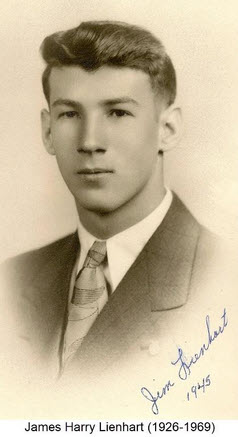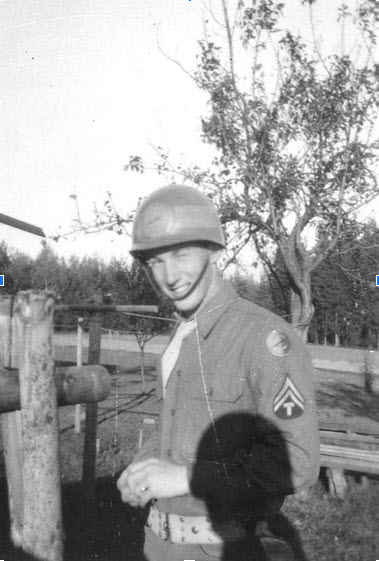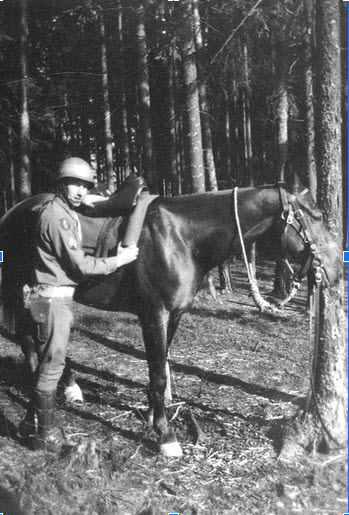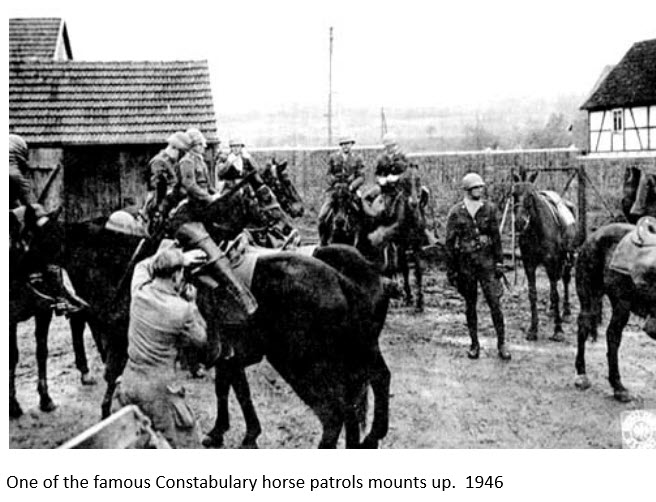This little history is about the military service of my dad, Jim Lienhart, based on a few of his comments that I remember, a short version of his official military record, and some Internet research. What I learned was that he was a member of the elite newly-created U.S. Constabulary when it began operating in Germany in 1946; an organization that played an important part in rebuilding post-war Germany.

James Lienhart’s senior picture at Dansville High School.
James H. Lienhart (1926-1969) received his draft notice in early 1945, when he was a senior at Dansville High School. It was mentioned in his yearbook that he was headed into the Army, so he apparently had a few months’ notice. Jim had attended the Catholic school at Saints Cornelius & Cyprian, next door to his home, through the 8th grade. His father and all nine of his father’s brothers and sisters had attended the same school. After 8th grade graduation Jim transferred to Dansville High. I know little about his high school years except that he was a starting End (Offense and Defense) on Dansville’s championship football team. In his senior year, the team was not only unbeaten, but his yearbook shows that no opponent scored even one point throughout the season.
Jim entered the Army on June 12, 1945, and headed off to Fort Riley, Kansas for training. The war in Europe had just ended in May with the suicide of Adolf Hitler and the surrender of the Nazi leaders. However, the war with Japan continued, with all of America expecting a U.S. amphibious invasion of Japan’s ‘home islands’ in late 1945. U.S. military leaders were in fact planning two invasions of Japan; the first in November 1945, to be followed by a second invasion at a different location about March 1946. Both were to be larger in scale than the 1944 Normandy invasion, and military planners expected that American casualties would be sky-high.
In August however, the U.S. Army Air Force dropped atomic bombs on Hiroshima and Nagasaki. This was a surprise to the American public, as development of the bombs had been a closely guarded secret. These attacks, along with other military developments such as Russia joining the war against Japan, persuaded Japan to surrender. The war with Japan ended in September 1945, so the invasions were called off. That was a great relief for all U.S. servicemen, and their mothers.
While the war came to an end in Japan, the allied governments of the U.S., Great Britain, the Soviet Union, and France discussed how best to govern and control defeated Germany, which was largely in ruins. The occupying armies needed to feed the German population as well as millions of refugees that were pouring into the country from Poland and other eastern European countries. The armies also had to provide a wide range of government services, while providing security and tracking down fugitive Nazis.
The Allied powers decided to divide Germany into four zones, each to be governed by military forces. The eastern zone was turned over to the Soviets, and the western part, which was much bigger, was divided into northern, southern and western zones. The British took the north, the French took the west, and the U.S. took charge of the southern part. The U.S. headquarters for the ‘occupation’ was in Frankfurt, and the first commander was General Eisenhower.
The U.S. and Allies kept hundreds of thousands of troops in Germany for the occupation, but for many reasons it was clear by the end of 1945 that the operation was not going well. In response, Army planners designed a specially trained force that they named the U.S. Constabulary, which would take over many of the policing and security duties from U.S. combat troops.
The Constabulary was modeled after State Police forces, which had been created in some U.S. states in the early 20th century. The Constabulary’s official history mentions that the State Police forces of New York and Pennsylvania were studied. I found that Michigan had also created such a force in 1917, during World War I. It was generally called the Michigan Constabulary at that time, but was reorganized into the Michigan State Police in 1919. All these new State Police Forces were in turn modeled on Canada’s Northwest Mounted Police.

Jim Lienhart in his Constabulary Platoon, Germany 1946

Jim Lienhart with his horse, Germany 1946
By the time the Constabulary was to begin operations on 1 July 1946, it was planned to have 30,000 men, organized into 3 brigades. Each brigade would have 3 regiments. Among the vehicles assigned to these nine regiments would be jeeps, trucks, light tanks, motorcycles, and surveillance aircraft. Finally, each regiment would have a single platoon of 30 horse cavalrymen. This small, elite unit of mounted men could travel in terrain such as woods and mountainous areas where even the jeeps couldn’t penetrate, so they had a special role. This role was summarized in the official U.S. Army history of the Constabulary:
“The Constabulary’s horse platoons were a unique feature of the early border patrol operations and deserve special mention. The platoon was small and compact, consisting of 1 officer and 32 enlisted men. The horses were former SS and Wehrmacht mounts that were well trained for their mission. The German population had an unusual amount of respect for a policeman on a horse, and the horses were excellent for crowd control. However, their biggest advantage was their ability to traverse rough terrain which was inaccessible to the wheeled and tracked vehicles. In addition to patrolling the border, they were used in a variety of operations to include raids on remote border hotels and rounding up cattle stolen by modern day “cattle rustlers,” which had been hidden in the woods to be picked up at a later date.”
Constabulary units along the border had to be on the look-out for smugglers, escaping Nazis, infiltrating Soviets, and migrating refugees. The official history also hints of additional classified (secret) responsibilities.
Jim Lienhart seems to have remained at Fort Riley from June 1945 until March 1946, going through training. His records show that he became a Cavalryman, and he went through training as a saddler. It seems surprising that the cavalry school was still operating during WWII, as motor vehicles and tanks had long ago replaced the horse cavalry. However, the cavalry school at Fort Riley had continued to provide excellent training for horsemen throughout the 1920s and 1930s. In World War II the army switched its focus to developing the armored cavalry (tanks) and de-emphasized the horse cavalry. The school at Fort Riley, then the Army’s only horse cavalry school, would be shut down permanently in November 1946.
Jim was ordered to West Germany in early 1946. He departed the U.S. on 30 March, probably by ship. Once in Germany, he probably participated in the extensive specialized training that was provided for members of the new Constabulary. He was assigned to the horse platoon of the 6th Constabulary Regiment and was probably on duty on the first day of the Regiment’s operations, July 1, 1946.
The headquarters of the 6th Regiment in 1946 was at Bayreuth, about 30-35 miles west of the point where the borders of East Germany, West Germany and Czechoslovakia met. I recall my dad saying he was stationed at a castle near Bayreuth. The various companies of the regiment were located in other towns in the area, but the cavalry platoon may have been attached to headquarters. I have not yet identified the castle where he lived.
In August 1946 Jim received his final promotion, to Technician 5th Grade (T/5). He would have been addressed as “Corporal”. About the end of October, he was transferred out of Germany, arriving in the U.S. in mid-November. He was then separated from the service on 21 Nov 1946 at Fort Dix, NJ, probably after several days of “out-processing”. His total military service was a bit less than 18 months, with about 7 months spent in Germany.
Why was his term of service so short? A normal Army enlistment is three years long. But because Jim was a wartime draftee, I believe he had a commitment to serve only until hostilities officially ended. Then the Army had to replace draftees such as him with soldiers who had enlisted.
The Constabulary in Germany would continue to evolve and carry out its special police duties until 1952. The Constabulary’s horse platoons are notable in Army history because this was the final non-ceremonial deployment of the U.S. Cavalry. The Constabulary itself stands out in U.S. Army history for its success in helping Germany make the transition from a Nazi dictatorship to a peaceful and prosperous democracy.
Below are some photos of Jim Lienhart, along with other photos and links about the Constabulary that I found online. I also served in the Army in Germany, in the late ‘70s, as a Military Policeman. I guess that’s why this is of special interest to me.
– Ted Lienhart


Examples of vehicles assigned to a Constabulary battalion. From left to right: M8 armored car; M24 light tank (Chaffee); Willys 1/4-ton jeep. Overhead flies an L-5 Sentinel Observation aircraft. 1946.

The Constabulary shoulder patch
Further Reading
US ARMY BORDER OPERATIONS IN GERMANY 1945-1983, by William E. Stacy
(Chapter 2 of this history covers the early years of the Constabulary)
https://history.army.mil/documents/BorderOps/content.htm
https://www.ibiblio.org/hyperwar/USA/ref/FM/PDFs/FM2-5.PDF
United States Zone Constabulary Trooper’s Handbook (Feb 1946)